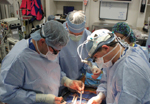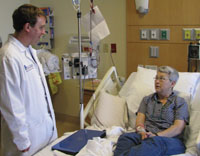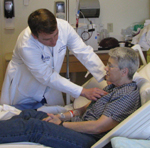|
By Dawn Brazell
Public Relations
The first thing Evin
Evans wants to do when she gets out of the hospital and home to her
farm is to take off her shoes, bury her bare feet into the earth and
breathe.
Breathe without it feeling
like she's sucking air through a piece of lava.
Breathe without the burden
of oxygen tanks weighing her down.
"I want to reconnect to
the land," she said in her hospital room as she began the tough road of
recovery from her March 9 double-lung transplant. "I'm not ever going
to take it for granted. Taking a breath is phenomenal. This is a big
deal. It's a big deal for me. It's a big deal for MUSC."
That it is.
Kim Phillips, R.N., and
transplant service line administrator, said this completes the one
missing piece of a well-established, multi-organ transplant center. It
also means that organs can remain in state as was the case for the last
transplant where the three viable organs remained in the state and went
to patients at MUSC.
Evans, who learned that
two other patients also were recovering at MUSC having received organs
from the same donor, got teary as a friend told her it was like she had
cousins now.
She took in the news,
nodding. "It's like we're family," Evans said of the gift. An organ
donor herself, Evans said no one knows until their life depends on
getting an organ what it feels like. "On one level, I underestimated
how grateful I would feel. It's a gift beyond what you can imagine."
MUSC had a lung transplant
program from 1994 to 1997, but it was discontinued after the chief
surgeon left. With the completion of Ashley River Tower and the key
recruitment of Timothy P.M. Whelan, M.D., of the University of
Minnesota to be the lung transplantation medical director and William
Yarbrough, M.D., of Stanford University as surgical director for the
lung transplant program, MUSC was able to offer the program again.
Whelan said MUSC is better
prepared now as there is a core group of surgeons involved and the
project is supported on all levels by the hospital, including the
departments of surgery and medicine.
 Pictured
from left are: Drs. John S. Ikonomidis, cardiothoracic surgery chief at
MUSC, Chadrick Denlinger, cardiothoracic surgeon, and William M.
Yarbrough, Lung transplant program surgical director, as they perform a
double lung transplant for Evin Evans. Pictured
from left are: Drs. John S. Ikonomidis, cardiothoracic surgery chief at
MUSC, Chadrick Denlinger, cardiothoracic surgeon, and William M.
Yarbrough, Lung transplant program surgical director, as they perform a
double lung transplant for Evin Evans.
A referral center for
patients with advanced lung disease, MUSC eventually will perform 30 to
40 transplants a year, Whelan said. He was drawn to this field because
lung transplantation affords patients a second chance. "All of these
patients are quite ill and would not remain alive despite our best
attempts at medical therapy. There is nothing like seeing a person who
is dependent on oxygen taking a deep breath with a set of lungs that
work perfectly."
MUSC's Pulmonary Division
is nationally recognized for its leaders in chronic obstructive
pulmonary disease, alpha-1-antitrypsin deficiency, pulmonary
hypertension, pulmonary fibrosis and cystic fibrosis, which are the
major diagnoses that are receiving transplants in the nation.
"Without transplant as an
option at MUSC, these patients had to go to a different center and meet
a whole new team. Needless to say, this is a burden to patients who are
already vulnerable from their advanced lung disease."
Other advantages to MUSC
having the program is that it expands educational opportunities for
MUSC residents and fellows and provides an opportunity for continued
research into advanced lung diseases, organ recovery and transplant
outcomes.
 Dr. William M. Yarbrough sees how
Evin Evans is feeling after her double lung transplant. Dr. William M. Yarbrough sees how
Evin Evans is feeling after her double lung transplant.
Whelan and Yarbrough were
pleased by Evans' progress. She was breathing on her own without oxygen
24 hours after coming out of the operating room, and discharged after
nine days. The average length of stay nationally for a lung transplant
is 22 days.
Evans needed lung
transplantation because she had end-stage lung disease as a result of
lung fibrosis. She was impaired to a large degree with respect to
performing basic activities and was dependent on supplemental oxygen,
said Yarbrough.
"Quite frankly, she
remained short of breath most of the time and was miserable as a
result. Without lung transplantation she would not likely have survived
more than another year or so. She really didn't have any other options,
and it was fortunate that she was otherwise in good condition so that
she could become a transplant candidate," he said. "Her success is a
testament to her fortitude as well as to the excellent care she has
received from numerous individuals at MUSC."
Both doctors are glad that
patients now can receive care closer to home and face shorter wait
times related to the allocation of organs for transplant. Phillips said
the program has benefitted from the hard work of a great team with
amazing leadership. "We never have to send lungs away. Local lungs can
stay locally. I'm so excited. This is a great resource to have."
 Dr. William Yarbrough checks Evin
Evans' vitals after her transplant. Dr. William Yarbrough checks Evin
Evans' vitals after her transplant.
Evans, 60, was dual listed
for her transplant at MUSC and Emory University School of Medicine, but
said she was glad to end up in state. "I felt I would gain a lot of
personal attention and I have," she said, adding that she had done her
research on her team and felt she was in safe hands. "I had been
embraced by the medical community in a way I haven't before in other
places I've been."
Owner of Split Creek Farm
that is known for its award-winning goat cheeses, Evans knows all her
350 goats by name. She's eager to return home when she finishes her
pulmonary rehabilitation. She said she knows her life will be more
constrained, but it won't be like it was. Before she couldn't even fly
to the international competitions she was asked to judge because of all
the oxygen equipment she was required to keep with her. Even walking
across a room tired her, and she had to take her oxygen with her to
shower.
Evans said she has spent
one-third of her life in denial about her illness, one-third crying and
one-third angry and depressed. Now that she has a second chance, she
smiles.
The next portion she wants
to spend in gratitude.
The Miracle of a Double
Lung Transplant
Editor's
Note: The following is a description of the steps involved with a
double lung transplant at MUSC.
Donor lungs become
available and candidates at the top of the waiting list are considered
for transplantation. The appropriate recipient is called to come to
MUSC and is prepared for surgery. Simultaneously, a lung-recovery
surgical team is dispatched to the donor hospital where the donor lungs
are assessed and inspected. If the lungs look good, then the transplant
surgeon and anesthesiology staff at MUSC are notified so that final
preparations can be made.
The recipient is placed
under general anesthesia and monitoring lines are carefully inserted.
An incision is made down the middle of the chest so that the breastbone
can be divided (i.e. sternotomy). This incision is the same incision
that is used for "open-heart surgery" and is the preference of the MUSC
lung transplant team. The incision down the front of the chest
("open-heart incision") requires the recipient to be placed on the
heart-lung machine for cardiopulmonary bypass during the transplant.
At MUSC, the heart-lung
machine is used for carrying out double lung transplants and this
allows both diseased lungs to be removed from the chest cavity of the
recipient in a stable fashion. Removal of the diseased lungs includes
division of the airways as well as the arteries and veins carrying
blood towards and away from the heart, respectively. Upon arrival to
MUSC, the new lungs are quickly, and safely, sewn into the chest of the
recipient. The airway of one lung is connected first. Then the veins
carrying oxygenated blood away from the lung are sewn to the left
atrium of the heart. Finally, the pulmonary arteries carrying
deoxygenated blood towards the lung are connected.
The same process is
repeated on the other side with the goal being to have both lungs sewn
into place in less than six hours from the time of their procurement at
the donor hospital. The new lungs are gently ventilated and the
recipient is separated from the heart lung machine. Drainage tubes are
inserted around the lungs to evacuate fluid and the chest is closed.
Patients are transported to the intensive care unit where they are
closely monitored and are taken off the ventilator as quickly as
possible. Medications are administered that suppress the recipient's
immune system so that they do not reject the lungs. These medications
are continued indefinitely. After spending a couple of days in the
intensive care unit, patients are promoted to the step-down unit where
aggressive rehabilitation begins. Patients typically remain
hospitalized anywhere from 10 to 20 days.
|



 Pictured
from left are: Drs. John S. Ikonomidis, cardiothoracic surgery chief at
MUSC, Chadrick Denlinger, cardiothoracic surgeon, and William M.
Yarbrough, Lung transplant program surgical director, as they perform a
double lung transplant for Evin Evans.
Pictured
from left are: Drs. John S. Ikonomidis, cardiothoracic surgery chief at
MUSC, Chadrick Denlinger, cardiothoracic surgeon, and William M.
Yarbrough, Lung transplant program surgical director, as they perform a
double lung transplant for Evin Evans. Dr. William M. Yarbrough sees how
Evin Evans is feeling after her double lung transplant.
Dr. William M. Yarbrough sees how
Evin Evans is feeling after her double lung transplant. Dr. William Yarbrough checks Evin
Evans' vitals after her transplant.
Dr. William Yarbrough checks Evin
Evans' vitals after her transplant.